Sotiris Malassiotis
Bridging the gap between learning and heuristic based pushing policies
Nov 22, 2021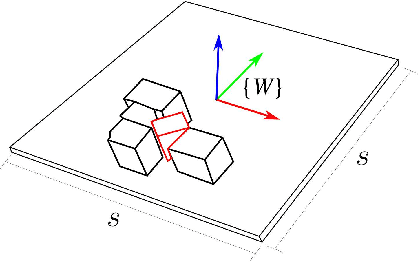
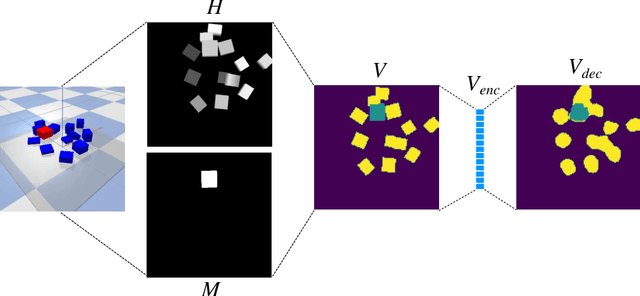


Abstract:Non-prehensile pushing actions have the potential to singulate a target object from its surrounding clutter in order to facilitate the robotic grasping of the target. To address this problem we utilize a heuristic rule that moves the target object towards the workspace's empty space and demonstrate that this simple heuristic rule achieves singulation. Furthermore, we incorporate this heuristic rule to the reward in order to train more efficiently reinforcement learning (RL) agents for singulation. Simulation experiments demonstrate that this insight increases performance. Finally, our results show that the RL-based policy implicitly learns something similar to one of the used heuristics in terms of decision making.
Split Deep Q-Learning for Robust Object Singulation
Sep 17, 2019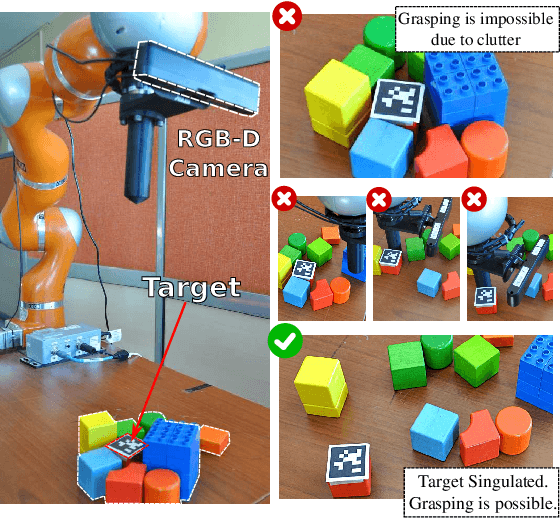
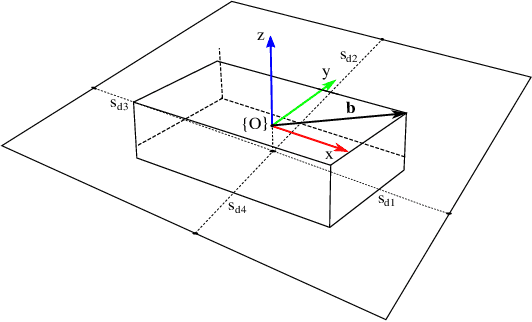
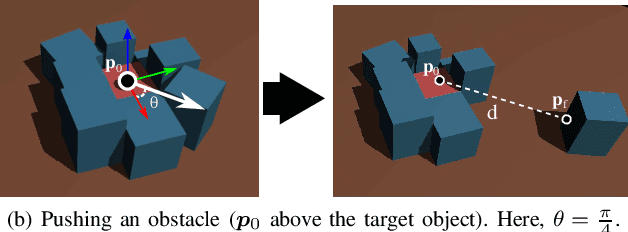

Abstract:Extracting a known target object from a pile of other objects in a cluttered environment is a challenging robotic manipulation task encountered in many applications of robotics. In such conditions, the target object touches or is covered by adjacent obstacle objects, thus rendering traditional grasping techniques ineffective. In this paper, we propose a pushing policy aiming at singulating the target object from its surrounding clutter, by means of lateral pushing movements of both the neighboring objects and the target object until sufficient 'grasping room' has been achieved. To achieve the above goal we employ reinforcement learning and particularly Deep Q-learning (DQN) to learn optimal push policies by trial and error. A novel Split DQN is proposed to improve the learning rate and increase the modularity of the algorithm. Experiments show that although learning is performed in a simulated environment the transfer of learned policies to a real environment is effective thanks to robust feature selection and learning. Finally, we demonstrate that the modularity of the algorithm allows the addition of extra primitives without retraining the model from scratch.
Recovering 6D Object Pose and Predicting Next-Best-View in the Crowd
Apr 19, 2016



Abstract:Object detection and 6D pose estimation in the crowd (scenes with multiple object instances, severe foreground occlusions and background distractors), has become an important problem in many rapidly evolving technological areas such as robotics and augmented reality. Single shot-based 6D pose estimators with manually designed features are still unable to tackle the above challenges, motivating the research towards unsupervised feature learning and next-best-view estimation. In this work, we present a complete framework for both single shot-based 6D object pose estimation and next-best-view prediction based on Hough Forests, the state of the art object pose estimator that performs classification and regression jointly. Rather than using manually designed features we a) propose an unsupervised feature learnt from depth-invariant patches using a Sparse Autoencoder and b) offer an extensive evaluation of various state of the art features. Furthermore, taking advantage of the clustering performed in the leaf nodes of Hough Forests, we learn to estimate the reduction of uncertainty in other views, formulating the problem of selecting the next-best-view. To further improve pose estimation, we propose an improved joint registration and hypotheses verification module as a final refinement step to reject false detections. We provide two additional challenging datasets inspired from realistic scenarios to extensively evaluate the state of the art and our framework. One is related to domestic environments and the other depicts a bin-picking scenario mostly found in industrial settings. We show that our framework significantly outperforms state of the art both on public and on our datasets.
 Add to Chrome
Add to Chrome Add to Firefox
Add to Firefox Add to Edge
Add to Edge